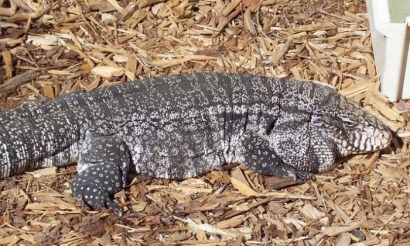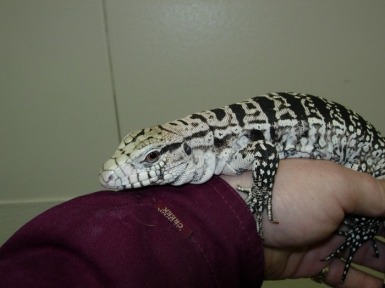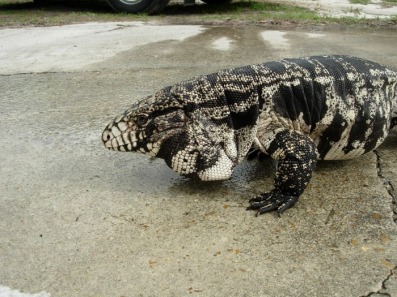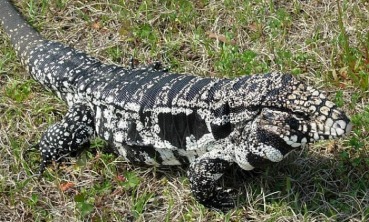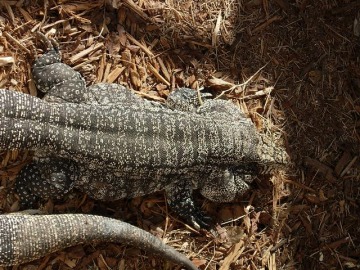THE TEGUS
Written By: Bobby Hill
www.Varnyard-Herps-Inc.com
Care sheet for the Tegu.
Note some species will differ some on requirements.
This care sheet will be for four of the common species available in the pet trade.
Hatchling tegus will all take the same food up until about one year in age. Of these the Tupinambis merianae, Common name (Argentine Black and White), (Giant Tegu) And the Tupinambis rufescens, Common name (Argentine red Tegu), (Red tegu) will change feeding habits. The Blue Tegu is also a form of the Tupinambis merianae, but the Tupinambis teguixin, Common name (Colombian Black and White), or (Gold Tegu) Will stay on a carnivorous diet throughout their life.
FOOD
All Tegus are carnivores as hatchlings, which means they only eat meat. I do allow baby tegus to eat as much as they want to, except rodents. I feed them one once or twice a week, and also make sure they are the size that can swallow without too much trouble. Crickets dusted with vitamins dust, Captive raised roaches, Mealworms, Super mealworms, ground turkey dusted with vitamin dust, Pinkie mice and cooked egg (Not raw) scrambled or hard-boiled. The only reptile supplement I have any faith in is Zoo-Med Repti Calcium without D3. Most other products are made from crushed oyster shells, and are not able to be absorbed. Therefore, being a poor product for a good healthy tegu.
As for my adults, I feed them everyday, as in the babies, the get one whole rodent, chick or duckling once or twice a week. However, my tegus do hibernate up to 7 months out of the year. If you have a tegu that does not hibernate, you can cut back on feeding him as much, or as frequent. Judged by the animal keeping good body weight, and a fat round tail base. If he starts to look like he might be loosing body mass, you can always add more to the diet.
Please remember to remove any food that is not eaten right after your tegu has eaten his/her fill. Insects are well known for stressing reptiles. This also will help keep their cage cleaner.
Adult tegus, for the Argentine Black and White and the Argentine red Tegu, the Blue Tegu and as well as the Extreme Giant tegus, they will take ground turkey; cooked egg (Not raw) scrambled or hard-boiled, rodents, fresh fish (Not from a pet shop, due to the chemicals used in these tanks), baby chickens, grapes, tomatoes, strawberries, melons, and just about any other soft fruits. Bananas can be given as well, but not as a staple diet, only in moderation. This is due to the high content of potassium (Known for not binding with calcium). Not more than once every couple of weeks. They also tend to have very high phosphorous levels. Some of my Argentine tegus will not eat fruit. They are just as healthy as any tegus that have fruit in the diet; they also have no shedding problems at all. The more I look into this, the more I see feeding fruit as being a waste of time and money. There are many things out there to feed your tegu that is much better than fruit. The Colombian Black and White, or (Gold Tegu) will take all of the above, except fruit. Also I suggest feeding only killed rodents. Live rodents can bite your animal. Dead do not; it is just not worth the chance. My choice of vitamin dust is Zoo-Med Repti Calcium without D3; it is made with calcium carbonate and not crushed oyster shell.
A side note on feeding: Tegus can get cage aggressive. They can get to where they will associate their keeper with food. There are a couple of ways to keep this from happening. The first is to feed your tegu in a separate cage or area than his home. Have the food there when you put him with it.
Another way, would be to feed him at night or when he is in his hide. Then he will not see you with food. The first suggestion is the best for a few reasons. One you handle him every day, which helps with the taming process. Another reason would be to remove all chances of him ingesting substrate. And last, but not least, the food would be fresher than feeding at night.
In my opinion, feeding fruit for skin problems has no solid ground to back the claims of some keepers. There is nothing in most fruits to promote good sheds but moisture, all though some fruits do contain some vitamins that are good for skin. There are other sources of these vitamins in much higher concentrations, these are found in meats. Feeding fruit seems to be nothing more than a wasted meal, and is not needed to have and keep a healthy tegu. There are other things that do contain the right vitamins, such as beef liver and cod liver oil. These need to be fed in conjunction with each other. Another words feed both of them once a week as a meal.
www.Varnyard-Herps-Inc.com
Care sheet for the Tegu.
Note some species will differ some on requirements.
This care sheet will be for four of the common species available in the pet trade.
Hatchling tegus will all take the same food up until about one year in age. Of these the Tupinambis merianae, Common name (Argentine Black and White), (Giant Tegu) And the Tupinambis rufescens, Common name (Argentine red Tegu), (Red tegu) will change feeding habits. The Blue Tegu is also a form of the Tupinambis merianae, but the Tupinambis teguixin, Common name (Colombian Black and White), or (Gold Tegu) Will stay on a carnivorous diet throughout their life.
FOOD
All Tegus are carnivores as hatchlings, which means they only eat meat. I do allow baby tegus to eat as much as they want to, except rodents. I feed them one once or twice a week, and also make sure they are the size that can swallow without too much trouble. Crickets dusted with vitamins dust, Captive raised roaches, Mealworms, Super mealworms, ground turkey dusted with vitamin dust, Pinkie mice and cooked egg (Not raw) scrambled or hard-boiled. The only reptile supplement I have any faith in is Zoo-Med Repti Calcium without D3. Most other products are made from crushed oyster shells, and are not able to be absorbed. Therefore, being a poor product for a good healthy tegu.
As for my adults, I feed them everyday, as in the babies, the get one whole rodent, chick or duckling once or twice a week. However, my tegus do hibernate up to 7 months out of the year. If you have a tegu that does not hibernate, you can cut back on feeding him as much, or as frequent. Judged by the animal keeping good body weight, and a fat round tail base. If he starts to look like he might be loosing body mass, you can always add more to the diet.
Please remember to remove any food that is not eaten right after your tegu has eaten his/her fill. Insects are well known for stressing reptiles. This also will help keep their cage cleaner.
Adult tegus, for the Argentine Black and White and the Argentine red Tegu, the Blue Tegu and as well as the Extreme Giant tegus, they will take ground turkey; cooked egg (Not raw) scrambled or hard-boiled, rodents, fresh fish (Not from a pet shop, due to the chemicals used in these tanks), baby chickens, grapes, tomatoes, strawberries, melons, and just about any other soft fruits. Bananas can be given as well, but not as a staple diet, only in moderation. This is due to the high content of potassium (Known for not binding with calcium). Not more than once every couple of weeks. They also tend to have very high phosphorous levels. Some of my Argentine tegus will not eat fruit. They are just as healthy as any tegus that have fruit in the diet; they also have no shedding problems at all. The more I look into this, the more I see feeding fruit as being a waste of time and money. There are many things out there to feed your tegu that is much better than fruit. The Colombian Black and White, or (Gold Tegu) will take all of the above, except fruit. Also I suggest feeding only killed rodents. Live rodents can bite your animal. Dead do not; it is just not worth the chance. My choice of vitamin dust is Zoo-Med Repti Calcium without D3; it is made with calcium carbonate and not crushed oyster shell.
A side note on feeding: Tegus can get cage aggressive. They can get to where they will associate their keeper with food. There are a couple of ways to keep this from happening. The first is to feed your tegu in a separate cage or area than his home. Have the food there when you put him with it.
Another way, would be to feed him at night or when he is in his hide. Then he will not see you with food. The first suggestion is the best for a few reasons. One you handle him every day, which helps with the taming process. Another reason would be to remove all chances of him ingesting substrate. And last, but not least, the food would be fresher than feeding at night.
In my opinion, feeding fruit for skin problems has no solid ground to back the claims of some keepers. There is nothing in most fruits to promote good sheds but moisture, all though some fruits do contain some vitamins that are good for skin. There are other sources of these vitamins in much higher concentrations, these are found in meats. Feeding fruit seems to be nothing more than a wasted meal, and is not needed to have and keep a healthy tegu. There are other things that do contain the right vitamins, such as beef liver and cod liver oil. These need to be fed in conjunction with each other. Another words feed both of them once a week as a meal.
The way I mix my beef liver into the ground turkey:
I use one part of beef liver to three parts ground turkey, just mince the liver, or you can use a food processor. You can mix it together and then portion pack them into meal size zip-lock bags, freeze them and then thaw them as needed to feed. As in the little stamp zip-locks for hatchlings, up to sandwich bags for adults. You can make up a bunch of them and freeze them. Also this is fed raw, I do not cook anything for tegus but eggs.
Raw beef liver contains:
Vitamin A iu (ug * 5) 35346.000 10020.591 39940.98 706.9%
Vitamin B1 (Thiamin) mg 0.260 0.07371 0.2938 17.3%
Vitamin B2 (Riboflavin) mg 2.780 0.78813 3.1414 163.5%
Vitamin B3 (Niacin) mg 12.780 3.62313 14.4414 63.9%
Vitamin B5 (Pantotheic Acid) mg 7.620 2.16027 8.6106 76.2%
Vitamin B6 (Pyridoxine) mg 0.940 0.26649 1.0622 47%
Vitamin C mg 22.000 6.237 24.86 36.6%
Vitamin E mg 0.670 0.189945 0.7571 4.4%
Water g 68.990 19.558665 77.9587 0
Zinc mg 3.920 1.11132 4.4296 26.1%
I use one part of beef liver to three parts ground turkey, just mince the liver, or you can use a food processor. You can mix it together and then portion pack them into meal size zip-lock bags, freeze them and then thaw them as needed to feed. As in the little stamp zip-locks for hatchlings, up to sandwich bags for adults. You can make up a bunch of them and freeze them. Also this is fed raw, I do not cook anything for tegus but eggs.
Raw beef liver contains:
Vitamin A iu (ug * 5) 35346.000 10020.591 39940.98 706.9%
Vitamin B1 (Thiamin) mg 0.260 0.07371 0.2938 17.3%
Vitamin B2 (Riboflavin) mg 2.780 0.78813 3.1414 163.5%
Vitamin B3 (Niacin) mg 12.780 3.62313 14.4414 63.9%
Vitamin B5 (Pantotheic Acid) mg 7.620 2.16027 8.6106 76.2%
Vitamin B6 (Pyridoxine) mg 0.940 0.26649 1.0622 47%
Vitamin C mg 22.000 6.237 24.86 36.6%
Vitamin E mg 0.670 0.189945 0.7571 4.4%
Water g 68.990 19.558665 77.9587 0
Zinc mg 3.920 1.11132 4.4296 26.1%
The way I mix my cod liver oil into the ground turkey:
I use one tablespoon of cod liver oil to one pound of ground turkey. You can mix it together and then portion pack them into meal size zip-lock bags, freeze them and then thaw them as needed to feed. As in the little stamp zip-locks for hatchlings, up to sandwich bags for adults.
Cod liver oil contains more vitamin A and more vitamin D per unit weight than any other common food. One hundred grams of regular cod liver oil provides 100,000 IU of vitamin A, almost three times more than beef liver, the next richest source; and 10,000 IU vitamin D, almost four times more than lard, the next richest source. Of course, cod liver oil is only consumed used in small amounts, but even a tablespoon (about 15 grams) provides well over the recommended daily allowance for both nutrients in humans. Cod liver oil is a natural source of vitamin D3.
In addition, cod liver oil contains 7 percent each of the elongated omega-3 fatty acids EPA and DHA. EPA is the precursor of important prostaglandin, localized tissue hormones that help the body deal with inflammation; and DHA is extremely important for the development and function of the brain and nervous system. So it's no surprise that in numerous studies cod liver oil has proven to be a powerhouse in fighting disease.
They both must be fed in conjunction with each other, the Cod liver oil is needed to metabolite the vitamin A in the beef liver.
This diet is the best way to promote good sheds in tegus, if you have a tegu with shedding issues, or even impactions, the combination above will be the best solution.
WATER
Tegus require fresh water on a daily basis. It also would be recommended that their water dishes/bowls be big enough to soak in.
HOUSING
Hatchlings will do great in a 20 long tank, but they will outgrow these fast. As an adult they require a much larger enclosure. I house mine outside in a 8 ft x 8 ft enclosure. Inside I use a 400 gallon showcase. If building your own cage, remember that these lizards are terrestrial (ground dwelling), So height would not be a necessity. I recommend at least a 6 feet long, 3 feet wide and 3 feet high.
I use one tablespoon of cod liver oil to one pound of ground turkey. You can mix it together and then portion pack them into meal size zip-lock bags, freeze them and then thaw them as needed to feed. As in the little stamp zip-locks for hatchlings, up to sandwich bags for adults.
Cod liver oil contains more vitamin A and more vitamin D per unit weight than any other common food. One hundred grams of regular cod liver oil provides 100,000 IU of vitamin A, almost three times more than beef liver, the next richest source; and 10,000 IU vitamin D, almost four times more than lard, the next richest source. Of course, cod liver oil is only consumed used in small amounts, but even a tablespoon (about 15 grams) provides well over the recommended daily allowance for both nutrients in humans. Cod liver oil is a natural source of vitamin D3.
In addition, cod liver oil contains 7 percent each of the elongated omega-3 fatty acids EPA and DHA. EPA is the precursor of important prostaglandin, localized tissue hormones that help the body deal with inflammation; and DHA is extremely important for the development and function of the brain and nervous system. So it's no surprise that in numerous studies cod liver oil has proven to be a powerhouse in fighting disease.
They both must be fed in conjunction with each other, the Cod liver oil is needed to metabolite the vitamin A in the beef liver.
This diet is the best way to promote good sheds in tegus, if you have a tegu with shedding issues, or even impactions, the combination above will be the best solution.
WATER
Tegus require fresh water on a daily basis. It also would be recommended that their water dishes/bowls be big enough to soak in.
HOUSING
Hatchlings will do great in a 20 long tank, but they will outgrow these fast. As an adult they require a much larger enclosure. I house mine outside in a 8 ft x 8 ft enclosure. Inside I use a 400 gallon showcase. If building your own cage, remember that these lizards are terrestrial (ground dwelling), So height would not be a necessity. I recommend at least a 6 feet long, 3 feet wide and 3 feet high.
HUMIDITY
Tegus require high humidity level 60%-70% for proper shedding as well as proper health. Misting on a daily basis is required. If you have another way to raise the humidity, that is fine. Remember not to have the substrate tacky.
SUBSTRATE
I recommend using cypress mulch, orchid bark, Lizard litter, Repti-bark or eucalyptus mulch. These should not be dusty dry or wet. You can mist them a little to keep the dust down, this will also raise the humidity. Make sure it is not tacky, as to stick to their feet. Also your tegu needs to be fed where he will not ingest these substrates. You do not want him to have a intestinal blockage.
LIGHTING
Ultraviolet light with a full-spectrum of light is a must!! Lights that emit UVB is a required item for this species of reptile. Ultraviolet lighting is important in the production of vitamin D3, which is necessary for calcium metabolism. There are some people that claim added vitamins of D3 would be a good substitute, however I do not. I do use a suppliment dust. But I do not depend on it for a substitute for UV lighting. The basking spot should be a max temp of 110*F, and the cool side is fine if it is in the 70s. I do not recommend heat of any kind on the cool side of the enclosure.
UNDERSTANDING UVB LIGHTING
UVB is very necessary in which vitamin D3 is produced in the skin of animals, and humans for that matter, and this is what also causes sunburns in humans. The vitamin D3 that is produced is responsible for regulating calcium metabolism. Vitamin D3 is obtained through UVB exposure, this is by natural sunlight or lighting that emits UVB light. I have no doubt that reptile species are unable to utilize dietary vitamin D3 through the stomach; they must have access to UVB. A lack of UVB and vitamin D3 can ultimately result in metabolic bone disease in reptiles, or what is known as rickets in humans.
You can find Bobby at his site: www.TeguTalk.com
